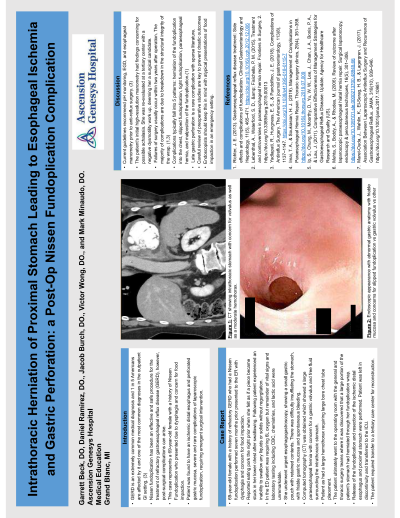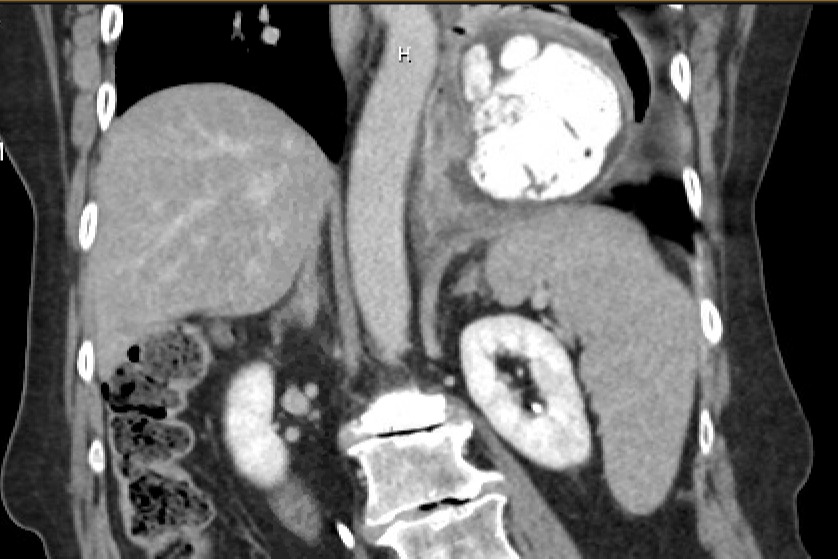Back


Poster Session B - Monday Morning
Category: Stomach
B0696 - Intrathoracic Herniation of Proximal Stomach Leading to Esophageal Ischemia and Gastric Perforation: A Post-Op Nissen Fundoplication Complication
Monday, October 24, 2022
10:00 AM – 12:00 PM ET
Location: Crown Ballroom

Has Audio

Garrett L. Beck, DO
Ascension Genesys Hospital
Grand Blanc, MI
Presenting Author(s)
Garrett L. Beck, DO, Daniel Ramirez, DO, Jacob Burch, DO, Victor Wong, DO, Mark J. Minaudo, DO
Ascension Genesys Hospital, Grand Blanc, MI
Introduction: Nissen fundoplication has been an effective and safe procedure for the treatment of refractory gastroesophageal reflux disease (GERD), however, post-surgical complications can arise. We describe a 69-year-old female with a history of Nissen Fundoplication who presented due to dysphagia and concern for food impaction. The patient was found to have an ischemic distal esophagus and perforated gastric mucosa, severe and rare complications of laparoscopic fundoplication, requiring emergent resection.
Case Description/Methods: A 69-year-old female with a history of refractory GERD who had a Nissen fundoplication performed seven months prior presented to the ER with dysphagia. The patient reported eating pork the night prior when she felt as if a piece became stuck in her lower chest after swallowing. Following this, the patient experienced an inability to swallow any liquids or solids without regurgitation. Labs including CBC, chemistries, and lactic acid were unremarkable. She underwent urgent esophagogastroscopy, showing a small gastric pouch with retained contents. There was difficulty insufflating the stomach, with friable gastric mucosa and spontaneous bleeding. The esophagogastroscopy (EGD) was aborted and the patient was sent for stat contrasted computed tomography (CT), which showed a large paraesophageal hernia with concern for a gastric volvulus and free fluid surrounding the intrathoracic stomach. The patient ultimately went to the operating room where it was discovered that a large portion of the patient’s stomach had herniated through her fundoplication wrap. Release of the fundoplication and resection of the ischemic distal esophagus and proximal stomach were performed. The patient required transfer to a tertiary care center for reconstruction.
Discussion: Current guidelines recommend pH monitoring, EGD, and esophageal manometry prior to anti-reflux surgery. The patient's initial high-resolution manometry had findings concerning for possible achalasia. She was reevaluated at a tertiary center with a negative dysmotility work up, deeming her a surgical candidate. Failures of surgery usually occur within two years after operation. The majority of complications are due to breakdown in the structural integrity of the wrap. Late gastric perforation is a rare complication with sparse literature. Careful review of preoperative studies are key to prevent drastic outcomes and endoscopists should keep this in mind with atypical presentations of food impaction in an emergency setting.

Disclosures:
Garrett L. Beck, DO, Daniel Ramirez, DO, Jacob Burch, DO, Victor Wong, DO, Mark J. Minaudo, DO. B0696 - Intrathoracic Herniation of Proximal Stomach Leading to Esophageal Ischemia and Gastric Perforation: A Post-Op Nissen Fundoplication Complication, ACG 2022 Annual Scientific Meeting Abstracts. Charlotte, NC: American College of Gastroenterology.
Ascension Genesys Hospital, Grand Blanc, MI
Introduction: Nissen fundoplication has been an effective and safe procedure for the treatment of refractory gastroesophageal reflux disease (GERD), however, post-surgical complications can arise. We describe a 69-year-old female with a history of Nissen Fundoplication who presented due to dysphagia and concern for food impaction. The patient was found to have an ischemic distal esophagus and perforated gastric mucosa, severe and rare complications of laparoscopic fundoplication, requiring emergent resection.
Case Description/Methods: A 69-year-old female with a history of refractory GERD who had a Nissen fundoplication performed seven months prior presented to the ER with dysphagia. The patient reported eating pork the night prior when she felt as if a piece became stuck in her lower chest after swallowing. Following this, the patient experienced an inability to swallow any liquids or solids without regurgitation. Labs including CBC, chemistries, and lactic acid were unremarkable. She underwent urgent esophagogastroscopy, showing a small gastric pouch with retained contents. There was difficulty insufflating the stomach, with friable gastric mucosa and spontaneous bleeding. The esophagogastroscopy (EGD) was aborted and the patient was sent for stat contrasted computed tomography (CT), which showed a large paraesophageal hernia with concern for a gastric volvulus and free fluid surrounding the intrathoracic stomach. The patient ultimately went to the operating room where it was discovered that a large portion of the patient’s stomach had herniated through her fundoplication wrap. Release of the fundoplication and resection of the ischemic distal esophagus and proximal stomach were performed. The patient required transfer to a tertiary care center for reconstruction.
Discussion: Current guidelines recommend pH monitoring, EGD, and esophageal manometry prior to anti-reflux surgery. The patient's initial high-resolution manometry had findings concerning for possible achalasia. She was reevaluated at a tertiary center with a negative dysmotility work up, deeming her a surgical candidate. Failures of surgery usually occur within two years after operation. The majority of complications are due to breakdown in the structural integrity of the wrap. Late gastric perforation is a rare complication with sparse literature. Careful review of preoperative studies are key to prevent drastic outcomes and endoscopists should keep this in mind with atypical presentations of food impaction in an emergency setting.

Figure: CT showing intrathoracic herniation of stomach
Disclosures:
Garrett Beck indicated no relevant financial relationships.
Daniel Ramirez indicated no relevant financial relationships.
Jacob Burch indicated no relevant financial relationships.
Victor Wong indicated no relevant financial relationships.
Mark Minaudo indicated no relevant financial relationships.
Garrett L. Beck, DO, Daniel Ramirez, DO, Jacob Burch, DO, Victor Wong, DO, Mark J. Minaudo, DO. B0696 - Intrathoracic Herniation of Proximal Stomach Leading to Esophageal Ischemia and Gastric Perforation: A Post-Op Nissen Fundoplication Complication, ACG 2022 Annual Scientific Meeting Abstracts. Charlotte, NC: American College of Gastroenterology.
